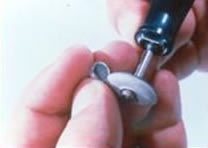Crown and Bridgework
The making of crown and bridgework requires meticulous attention to detail in order to achieve success. Adhering to ideals is essential; we adhere strictly to the following:
- Patient Comfort during and after treatment is essential. We always treat our patients with tender loving care.
- There is no guesswork so the best possible outcome is assured. Restorations fit perfectly—something quite different from restorations that “go on”. Two visit crown and bridgework often incorporates errors in casting, soldering and porcelain structure that can’t easily be identified and corrected. Errors compromise the final result and open the door to future trouble. When steps are not skipped, there is never discomfort and certainly no hammering or banging of crowns and bridges to make them fit. Any error is easily identified and corrected before going on to the next step. While extra steps mean extra visits, these visits are usually short, ½ hour visits or less that don’t require anesthesia. We believe a few extra visits are a small price to pay for restorations that will last a lot longer in health.
- All restorations are prepared and hand-carved in our private office. All crown and bridgework is custom-made and hand finished by the Doctor, in his in-office lab. Restorations are never “outsourced” to distant (and sometimes foreign) laboratories. Dentistry from laboratory models always requires refinement as it is almost always oversized. Oversized restorations are not only unaesthetic, they overload the supporting structures and contribute to periodontal problems.
- Only precious materials are used. Unlike non-precious materials,precious metals cast with a high degree of accuracy and have higher bond strengths to porcelain than non precious metals The casting that comes out of the oven fits the die (an exact duplicate of the patient’s prepared tooth) perfectly. We never ream the inside of a casting to make it fit the die or the tooth—that is unscientific and can compromise the end result.
Materials For Crown and Bridgework
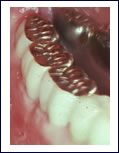
Gold is the best restorative material ever devised for dentistry. The most common type of gold used for dentistry is about 18 carat. Of all the materials, gold has the best fit, and by far the longest history of evidence-based success. Most people do not want to show gold, so this option—even if it is better—is no longer commonly offered. However, gold restorations can often be veneered with processed acrylic or (laboratory processed bonding composite materials that are highly esthetic.

Porcelain-Fused-to-Metal. Porcelain is the most esthetic material ever devised for Dentistry. When it is fused to metal, the color of the metal must be masked with an opaque porcelain. Porcelain cannot be baked on pure gold because gold melts at the temperature required to fuse porcelain. There are many different alloys available for porcelain-to-metal restorations. The precious metal alloys, which contain varying amounts of gold, silver, palladium, platinum and other noble metals, are all suitable for porcelain-fused-to-metal restorations. Nonprecious metals, however, are not. They do not cast with the same accuracy and the porcelain fused to it has a higher incidence of breakage.

All-Ceramic or “Metal-Free” restorations are the most esthetic restorations in dentistry, since they can be designed as translucent as natural teeth. These restorations can be baked, pressed or milled. However, all ceramic restorations do not fit with comparable accuracy to metal restorations. Because ceramic restorations cannot have thin aprons that extend under the gum, they cannot seal the teeth as effectively. They depend on bonding materials to seal the voids—materials that can be inconsistent because they are so technique sensitive. These inconsistencies often lead to decay in a susceptible individual. Ceramic restorations work best in the front of the mouth where they are easily accessible for hygiene.
A Precision Approach is Essential to the Success of Crown and Bridgework
Dentistry is continuously subjected to forces in a moist, wet environment loaded with bacteria. Tenths of millimeters often make the difference between success and failure. It is critical that ideals be followed to prevent future problems. Health care starts with a sound diagnosis of functional and esthetic problems, and a great deal of study goes into each diagnosis to ensure that the best plan is chosen for a patient.
Full coverage restorations (crowns and bridgework) are the only restorations that can maximize esthetics, create ideal architecture, compensate for periodontal bone loss and prevent periodontal problems by minimizing forces from an engineering standpoint.
Three Dimensional Preparation
The mouth is prepared according to a three dimensional approach so that the teeth relate to each other, the bone and the gums. This is the healthiest architecture that can be created for dental restorations. Unless extensive periodontal treatment is required, the preparation of the gingival (gums) and bone—if necessary—takes place at the same time the teeth are prepared.
Posts may be part of the preparation if a tooth has had root canal treatment (endodontics). ( Read more about Root Canal Therapy and Posts)
The Importance of Temporary Restorations

A great deal of time is spent creating temporary restorations that promote patient comfort, periodontal health, proper function and esthetics. Every effort is made to ensure that patients always walk out of the office with beautiful teeth, that they look and feel better than when they walked in, and that they are confident that their temporaries won’t easily dislodge between visits. We consider temporaries to be blueprints for our final restorations. Final restorations of similar dimensions and design as the temporaries comfortable the moment they are inserted.
Individual Copper Band Impressions of Teeth
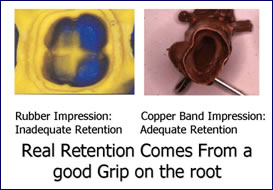
Once health has been created, individual impressions with copper bands are taken of each tooth to ensure precision fit of the Dentistry. Copper band impressions ensure adequate retention of restorations. Most dentists try to retain their crowns on tooth structure above the gum, and often there is not adequate tooth structure for this purpose. The rubber impressions usually do not capture enough root surface for adequate retention, so crowns do not fall out. The strategy of most dentists is to build up the tooth with core materials or perform root canal therapy so that posts can be placed. With the copper band technique, the amount of tooth structure above the gum is meaningless because retention comes from getting an adequate grip on the root surface below the gum.
Protection Against Decay
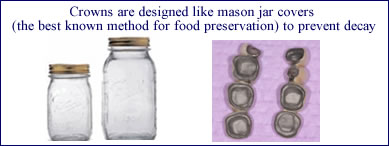
Our crowns are also designed on the principle of the mason jar cover—the best known method of preserving food from bacterial contamination. As a result, susceptibility to decay under crown and bridge restorations is virtually eliminated. The restorations, which are individually fabricated from the finest precious materials, are fitted to perfection. They are never forced on or mutilated to achieve fit. In fact, dental restorations fit so well that they are usually worn with Vaseline ointment for a trial period before permanent cementation and they do not leak or fall out.
Protection Against Periodontal Disease: Sound Engineering Principles
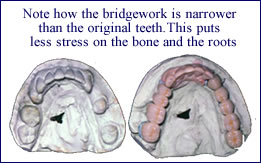
Every effort is made to create dentistry according to sound engineering principles. All dentistry-whether crowns, bridgework, precision attachment partial dentures or implants—are feats of engineering. There have been famous engineering disasters (e.g. the Tacoma Narrows Bridge and the Kansas City Hyatt Hotel skywalks) that failed to take into account the forces being applied to the foundations and the materials that must withstand them. Successful crown and bridgework brings the forces close to the supporting structures, minimizes their effects on the roots and surrounding bone and evenly distributes the load that must be carried. It also facilitates hygiene and prevents food impaction. Ideal engineering of dental restorations corrects deformities by changing the shape, size, inclination, position in the arch and color of the teeth.
How long does Dentistry last?

When done properly, good dentistry can last many years in health. The precise longevity of restorations, however, depends on many factors. The body changes during the aging process; and changes also occur in the mouth. Changes in metabolism, the development of systemic conditions, and the wear of the materials may necessitate the replacement of dentistry. Some individuals have worn dentistry for more than 40 years and do not require new restorations because changes have been minimal. Others may require new restorations after ten years. The goal of successful dentistry is that the teeth remain healthy enough for new restorations when replacement becomes necessary after many years of service.

